-
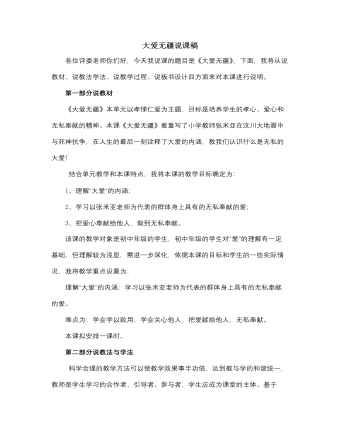
人音版小学音乐五年级下册大爱无疆说课稿
学生A回答:我会学习张米亚老师的无私奉献精神,去帮助大家,去挽救更多的生命。学生B回答:我会尽我所能去就我能救得每一个人。学生C回答:我会从现在开始,多学习有关地震方面的知识,万一遇上,可以合理指挥现场,把损失降到最小。教师总结:总而言之,在灾难来临之时,我们要学习张米亚老师身上无私奉献的精神,勇于挺身而出。这一环节的设置,使学生积极主动,合作交流,在思考和讨论中加深理解和体验,有所感悟,从而收到情感熏陶获得思想启迪,进而解决了教学重点,突破了教学难点。第四环节拓展延伸知识迁移请同学们阅读课本36页的相关链接文章《冰雪为容玉作胎》,结合本课内容谈谈你的读后感。本环节的设置拓展了学生的知识面和阅读范围,使学生学以致用,培养了学生的应用探究能力。第五环节 歌声陶冶振奋精神全班齐声合唱韦唯的著名歌曲《爱的奉献》结束全课。
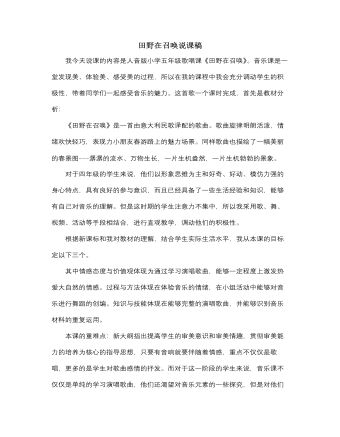
人音版小学音乐五年级下册田野在召唤说课稿
当学生有了较为深刻的情感体验时,再进行认知教学,就能达到事半功倍的效果。这一片段采用了合作学习、自主探究的教学方式,注重引导学生在学习实践中学会发现问题、解决问题,使之从小养成主动学习、互动、关注、欣赏他人的品质。在巩固提高环节,为了更好的了解音乐,首先老师邀请学生演唱伴奏,教师跳舞,激起学生对舞蹈的兴趣。接着通过分解动作的讲解关键的舞蹈动作,并通过小组创编的形式来增加学生音乐的表现力,使之在玩玩跳跳中轻松达到教学目标。在课堂小结部分我引导学生回忆本节课的内容,并在歌声中边舞蹈边结束今天的音乐课。最后是板书设计,其中展现的是歌曲的节奏难点和情绪,使得学生能够准确的了解本节课的重难点,能起到提纲挈领的作用。
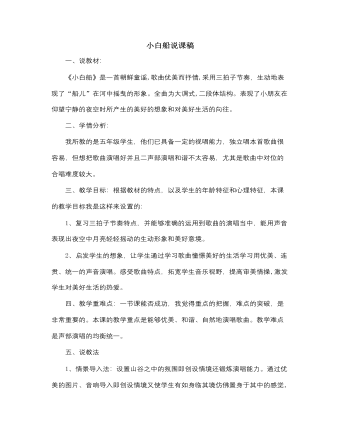
人音版小学音乐五年级下册小白船说课稿
多媒体让学生直观地掌握好音高,巩固歌曲旋律的掌握,积累读谱经验。六、创造表现-----享受过程在学生能熟练演唱的基础上,让学生选择竖笛为歌曲伴奏,还可以让学生边唱边即兴表演。让学生自由组合分成打击乐器组、演唱表演组和竖笛组,调动学生多种感官参与音乐体验和表现,加深了对这一音乐作品的感受,获得审美体验。这里我启发学生用自己喜欢的各种方式来表现歌曲,可以是身体语言、也可以是打击乐器。门德尔松说过一首我喜爱的乐曲,所传给我的思想和意义是不能用语言表达的。通过充分的音乐实践培养学生的能力,提高音乐素养。从目标的提出、到过程的安排、学习方法的确定、乃至学习成果的呈现,都让学生有更大的自主性、更多的实践性、更浓的创造性,让学生的音乐课堂更加丰富,教学成效更加明显。
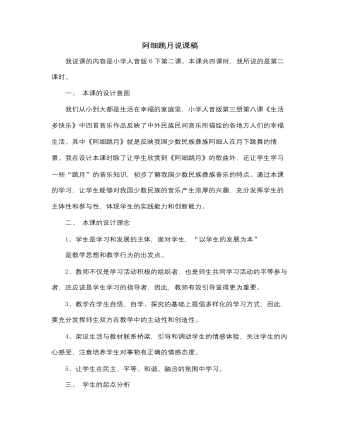
人音版小学音乐六年级下册阿细跳月说课稿
这一环节中,学生初步感受乐曲的主题旋律,学习“跳月”的舞蹈动作,并能够跟着琴来学唱《阿细跳月》的主题旋律。学生在这一环节中非常活跃,与教师的互动也很和谐。把课堂推上了一个小的高潮,不知不觉中解决教学难点。第三环节:听赏乐曲,复习巩固本环节设计三次让学生完整的欣赏乐曲。第一次让学生完整听,感受乐曲旋律的欢快跳跃的感觉,第二次听时让学生思考问题去听,第三次让学生跟着乐曲作“跳月”的动作。三次整的欣赏学生对《阿细跳月》又有了新的了解。第四环节:介绍乐曲,丰富知识学生对《阿细跳月》的了解非常的少,教师简单的介绍它的知识,再一次吸引学生的注意力,让学生对我国少数民族的音乐兴趣更加的浓厚。教师与学生一同跳起欢快的舞蹈,把课堂再次推向高潮。教师在高潮中结束本课。在这堂课中,学生愉快的学习了知识,充分发挥了他们的主体性和参与性,体现了学生的实践能力和创新能力。
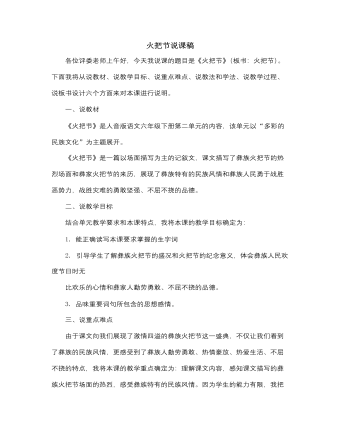
人音版小学音乐六年级下册火把节说课稿
同学们,看了这个传奇故事,那你们知道彝族人身上都体现了一个怎样的精神品质呢?此问题的设计既调动了学生的发散性思维,又可培养学生对彝族人精神品质的敬畏之情。环节5:研读赏析新课标中明确指出:“阅读是学生个性化的行为,不应以教师的分析来代替学生的阅读实践。”教师给学生充足的时间,让学生带着感情读出你喜欢的句子或段落,说出自己喜欢 的理由或者感受。其他学生可以适时做补充,或者引发讨论,让学生在积极主动的思维和讨论中,加深理解和体验,有所感悟和思考,从而受到情感熏陶获得思想启迪,进而解决教学难点。环节6拓展延伸1.写一个场面描写。2.用你喜欢的方式表达你的情感发挥学生想象力,理论-实践,学以致用。六、说板书设计好的板书就像一份微型教案,此板书力图全面而简明的将授课内容传递给学生,清晰直观,便于学生理解和记忆,理清文章脉络。
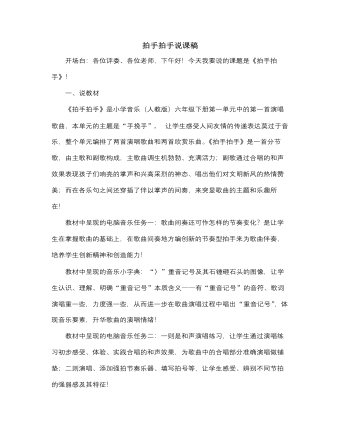
人音版小学音乐六年级下册拍手拍手说课稿
全体四人小组讨论编创间奏节奏变化,并进行练习!(巡视引导)之后,全体同学集中汇报各自小组的编创成果,如下:(1) X —(2) X X X其余同学评价该组的编创成果全体学生随乐用新的间奏节奏型拍手演唱歌曲(播放音乐)创造是发挥学生想象力和思维潜能的音乐学习领域,引导学生进行即兴式探究创造活动,是学生积累音乐创作经验和发掘创造思维能力的过程与方法。今天这节课,你有哪些学习收获?学生就会提出自己的收获,如:学会了这首歌曲《拍手拍手》,认识了“﹥”,知道了朋友间的友谊、友情是可以通过掌声来传递的……等等!引导学生对自己学习情况进行梳理和小结,明确各自在当堂课中的音乐学习信息,来促进今后的音乐学习质量和效率的提升!六、说板书我的板书设计是根据教学中需要和学生交流的关键知识点设计的,便于学生在总结学习收获时,梳理自己的音乐学习信息,明确学习重难点,并加深学习印象!
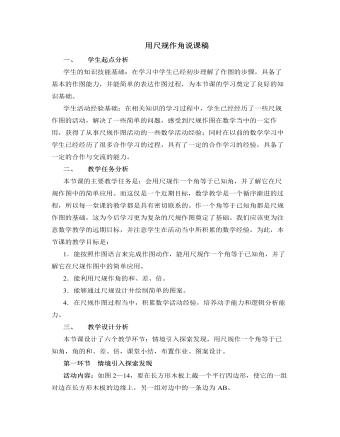
北师大版初中七年级数学下册用尺规作角说课稿
活动目的:通过两个图案设计,一个是让学生独立思考,借助于已经学习的用尺规作线段和角来完成,对本节课的知识进一步巩固应用;另一个是让学生根据作图步骤借助于尺规完成图案,进一步培养学生几何语言表达能力,并积累尺规作图的活动经验。活动注意事项:根据课堂时间安排,可灵活进行处理,既可以作为本节课的实际应用,也可以作为课下的联系拓广,从而使得不同层次的学生都学到有价值的数学。四、 教学设计反思1.利用现实情景引入新课,既能体现数学知识与客观世界的良好结合,又能唤起学生的求知欲望和探求意识。而在了解基础知识以后,将其进行一定的升华,也能使学生明白学以致用的道理、体会知识的渐进发展过程,增强思维能力的培养。同时,在整个探究过程中,怎样团结协作、如何共同寻找解题的突破口,也是学生逐步提高的一个途径。
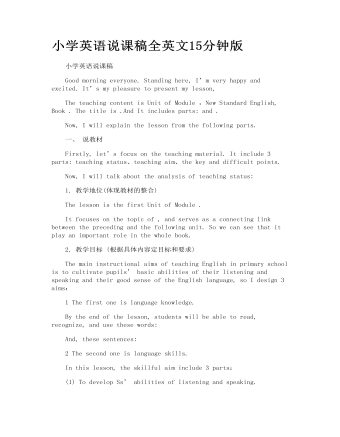
小学英语说课稿全英文15分钟版
一、 说教材 Firstly, let’s focus on theteaching material. It include 3 parts: teaching status、teachingaim、the key and difficult points. Now, I will talk about the analysis of teaching status: 1. 教学地位(体现教材的整合) The lesson is the first Unit of Module . It focuses on the topic of , and serves as a connectinglink between the preceding and the following unit. So we can see that it playan important role in the whole book. 2. 教学目标 (根据具体内容定目标和要求) The main instructional aims of teaching English inprimary school is to cultivate pupils’ basic abilitiesof their listening and speaking and their good sense of the English language,so I design 3 aims:
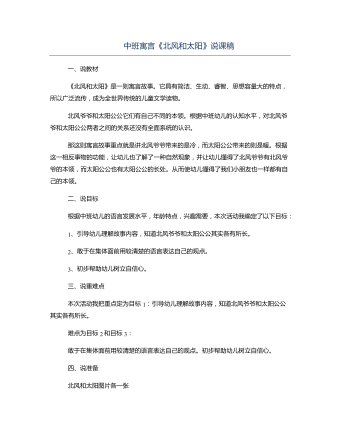
中班寓言《北风和太阳》说课稿
《北风和太阳》是一则寓言故事。它具有简洁、生动、睿智、思想容量大的特点,所以广泛流传,成为全世界传统的儿童文学读物。北风爷爷和太阳公公它们有自己不同的本领。根据中班幼儿的认知水平,对北风爷爷和太阳公公两者之间的关系还没有全面系统的认识。那这则寓言故事重点就是讲北风爷爷带来的是冷,而太阳公公带来的则是暖。根据这一相反事物的功能,让幼儿也了解了一种自然现象,并让幼儿懂得了北风爷爷有北风爷爷的本领,而太阳公公也有太阳公公的长处。从而使幼儿懂得了我们小朋友也一样都有自己的本领。
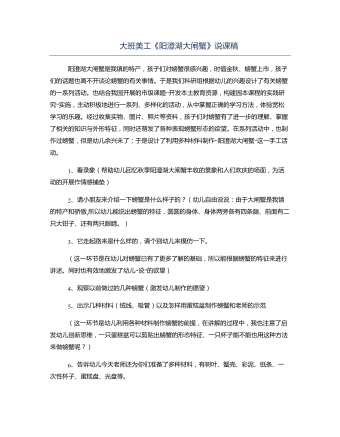
大班美工《阳澄湖大闸蟹》说课稿
阳澄湖大闸蟹是我镇的特产,孩子们对螃蟹很感兴趣,时值金秋、螃蟹上市,孩子们的话题也离不开谈论螃蟹的有关事情。于是我们科研组根据幼儿的兴趣设计了有关螃蟹的一系列活动。也结合我园开展的市级课题“开发本土教育资源,构建园本课程的实践研究”实施,主动积极地进行一系列、多样化的活动,从中掌握正确的学习方法,体验宽松学习的乐趣。经过收集实物、图片、照片等资料,孩子们对螃蟹有了进一步的理解、掌握了相关的知识与外形特征,同时还萌发了各种表现螃蟹形态的欲望。在系列活动中,也制作过螃蟹,但是幼儿余兴未了;于是设计了利用多种材料制作“阳澄湖大闸蟹”这一手工活动。1、看录象(帮助幼儿回忆秋季阳澄湖大闸蟹丰收的景象和人们欢庆的场面,为活动的开展作情感铺垫)2、请小朋友来介绍一下螃蟹是什么样子的?(幼儿自由说说:由于大闸蟹是我镇的特产和骄傲,所以幼儿能说出螃蟹的特征,圆圆的身体、身体两旁各有四条腿、前面有二只大钳子、还有两只眼睛。)
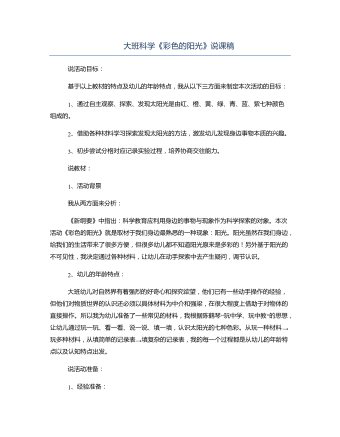
大班科学《彩色的阳光》说课稿
《新纲要》中指出:科学教育应利用身边的事物与现象作为科学探索的对象。本次活动《彩色的阳光》就是取材于我们身边最熟悉的一种现象:阳光。阳光虽然在我们身边,给我们的生活带来了很多方便,但很多幼儿都不知道阳光原来是多彩的!另外基于阳光的不可见性,我决定通过各种材料,让幼儿在动手探索中去产生疑问,调节认识。大班幼儿对自然界有着强烈的好奇心和探究欲望,他们已有一些动手操作的经验,但他们对物质世界的认识还必须以具体材料为中介和强梁,在很大程度上借助于对物体的直接操作。所以我为幼儿准备了一些常见的材料,我根据陈鹤琴“玩中学、玩中教”的思想,让幼儿通过玩一玩、看一看、说一说、填一填,认识太阳光的七种色彩。从玩一种材料→玩多种材料,从填简单的记录表→填复杂的记录表,我的每一个过程都是从幼儿的年龄特点以及认知特点出发。

人教版高中英语必修1Journey Down the Mekong说课稿
2. let the Ss complete the forms paragraph by paragraph. Purpose here is to help Ss to get the habit of reading a passage as a whole, and pay attention to the organization of the text, as a result the Ss will fully understand the whole passage.3. ask Ss to retell the passage with the help of the key words in the form.Since the Ss in the class are in different levels, so I let them to fill in the blank to understand the meaning of the words and phrases better. ( That’s all for the while-reading. Now let’s move to the fifth step.)Step V: Post-reading (10mins) ---DiscussionIn this part students are asked to discuss in groups and list Wang Kun’s and Wang Wei’s attitudes about the trip. After that, Ss are encouraged to express their attitudes with the whole class. Collect their answers and don’t forget to praise them even if their answers may not be perfect.In this activity, discussion provides a vivid and active learning environment for Ss to communicate in English with newly learned language items. (Finally it comes to the homework.)StepⅥ: Homework (1min)1. Ss are required to read the text again after class and figure out the meaning of some complex sentences.2. Do the exercises on P19; This can help Ss to consolidate what they’ve learnt and make preparation for the next lessonPart4. Blackboard design.(说板书设计)On the top, there is the title of this lesson. On the left, there are main ideas for each paragraph. On the right, there are some new words and expressions.Unit 3 Travel journalJourney down the MekongMain idea of each para.:Para1: deciding to take a great bike trip along the Mekong river.Para2: Different attitudes between Wang kun and Wang wei.

人教版高中英语必修4Body Language说课稿4篇
Textbook: Senior English for China (Book 4), by Liu Daoyi Time Allotment: 1 period (40 minutes)Date: March 20, 2014Teaching aids: blackboard, Multi-media, Power Point, chalk I. Text Analysis (教材分析)This unit is about body language, and the text selected in the reading part demonstrates the difference and similarity of body language in many parts of the world. Through learning this passage, students are required to raise their awareness of using body language in different parts of the world. As body language is closely related to our daily life, it is easy to arouse students’ interest in learning this text. Reading skills and speaking training are designed around the text.II. Teaching Objectives (教学目标)By the end of the lesson, students will be able to:1. Language Skill Objective(语言技能目标): develop reading ability (skimming and scanning)as well as speaking ability.2. Cultural Knowledge Objective(文化知识目标): know about the cultural differences of using body language.3. Affective Objective(情感目标): increase students’ awareness of using body language correctly in different cultures. III.Teaching Focuses and Difficulties(教学重点和难点)1. Teaching Focuses(教学重点): the difference and similarity of body language in many parts of the world.2. Teaching Difficulties(教学难点): develop students’ reading abilities of skimming and scanning and ask the students to show their opinions with fluent English.

人教版高中英语必修1Anne's best friend说课稿
Step 7 Language points 1.Vocabulary (1) go through (2) set down (3) a series of (4) on purpose (5) in order to (6)at dusk (7)entirely (8)face to face 2.Important sentences (1)…I’ve grown so crazy about everything to do with nature. (2)There was a time when … (3)I stayed awake on purpose until … (4)It was the first time … that I’d seen the night … (5)It’s no pleasure looking through … Purpose: 1.Master the required vocabulary and sentence structures. 2.Use them freely. Step 8 Consolidation 1.Find out the topic sentences 2.Retell the text according to the topic sentences Purpose: I want to know if my students understand the text. Step 9 Discussion Imagine you have to go into hiding like Anne and her family, what would you miss most? Giveyour reasons. Purpose: Train Ss’ oral English ability. Step 10 Homework Write an article on Friends. Purpose: 1. Improve the Ss’ writing ability. 2 Train the Ss’ ability of self—teaching and looking up information by themselves. Part 5 Blackboard design(说板书设计)Unit 1 Friendship Reading Anne’s Best Friend 1.Main idea of each paragraph: Para. 1 Anne made her diary her best friend. Para .2 Anne wrote her feelings in her diary. Para .3 Anne missed nature. Para.4 Anne saw the night face to face Para.5 Anne wanted to experience nature outdoors. 2.Listening: Exx.1 P3 3.Discussion: Exx.3 P3 Purpose: 1.Make Ss familiar with the passage 2.Make the design inductive, instructive and artistic.

人教版高中英语必修1Nelson Mandela--A Modern Hero说课稿
In this step, give students a few minutes to read the passage . While they are reading, I will write some key words of the text on the blackboard. Then ask students to retell the passage according to the key words.By retelling, students can improve their ability of language organization and have an overall understanding of the article.Step 4 Group discussionIn this step, students will be divided into groups of 4 to discussion the following question: What qualities make a great person?After their discussion, invite a few groups to make a report to the class.This group discussion can practice students’ oral English and cultivate their abilities of cooperation and communication.Step 5. HomeworkLet students write a short passage to introduce a great person he or she admires.The homework can consolidate the knowledge the students have learned and cultivate their writing ability. Part 6 Blackboard Design(板书设计)That’s all my teaching procedures. Finally, I’d like to say sth about part 6 blackboard design. On the top is the title. On the left, there will be some new words and expressions. In the middle of the blackboard, I will write some useful sentence structures so that the students can know clearly what they’ve learned and then try to master the knowledge.OK. That’s all for my presentation. Thank you for your attention.

人教版高中英语必修2Computers说课稿3篇
一. 教材分析1. 本单元的中心话题是“计算机(Computers)”,内容涉及计算机的发展历史,计算机的应用等。本节课是该单元的第一课时,我将Warming up, Pre-reading and Comprehending这四部分整合为一节精读课。其中。Reading部分是题为WHO AM I?的文章,以第一人称的拟人手法介绍了计算机发长演变的历史和计算机在各个领域的应用,其主旨是表达计算机的发展变化之快以及在生活中用途之广。而Warming up部分以图片的形式展现了计算机的发展历程;Pre-reading中的问题和排序分别是为了预测语篇的内容和测试学生对计算机历史了解的情况;Comprehending则通过各项练习训练学生的阅读技能,从而加深对文章的理解。可见这几部分是一个有机的整体。2. 教学目标:1) 语言目标:重点词汇及短语:abacus, calculate, calculator, PC, laptop, PDA, robot, analytical, technological, universal, mathematical, artificial, intelligent, network, explore, in common, as a result.重点句子:a. My real father was Alan Turing, who in 1963 wrote a book to describe how computers could be made to work, and build a “universal machine” to solve any mathematical problem.

人教版高中英语必修2Cultural Relics说课稿2篇
Ⅲ. Analysis of the teaching material:The topic of this unit is cultural relics. Students are quite interested in topics about different cultures around the world. This is the second period of the whole unit. As a reading class, the passage mainly talks about the history of the amber room (how it was made, sent as a gift, lost and rebuilt).According to the new national curriculum, when teaching reading, much emphasis should be put on training the students’ reading skills.Ⅳ. Teaching objectives1. Language objectives:1) Students are required to master the key words and phrases occurred in the passage (e.g. amazing, decorate, belong, in return, less than etc.)2) Students are required to learn the attributive clause and acquire the sentence pattern.2. 1) Students are required to describe a certain thing by using the new sentence patterns.2) Students are required to master two kinds of reading skills—skimming and scanning, and learn to use them in their daily reading.3. 1) Students are required to know the history of the amber room.2) Students are required to appreciate cultural relics and understand the importance of protecting them.Ⅴ. Teaching important and difficult points1) the new words, phrases, and sentence pattern in the course of reading.2) Teaching difficult point: Help the students master two kinds of reading skills—skimmingand scanning and learn to apply them in daily use.Ⅵ. Teaching methods:Task-based method & Top-down model Ⅶ. Teaching aids: PPT, pictures, blackboard Ⅷ. Teaching procedure:

人教版高中英语必修2The Olympic Games说课稿2篇
Purpose of my design:To ask the students to do these two tasks will make the Ss predict the story of this passage. As a result, it will deepen Ss’ memory of this story because they will have their own understanding of this story.Step 3. While-readingTask 1. (Individual work _____min)Skimming: ask students to skim the text and the main ideas of each paragraph in this passage. Please read it quickly and then match the sentences with the letters.Task 2. (Individual work _____min)Scanning: read the text quickly and decide the whether the following statements are true or false and give reasons.Task 3. (Pair work _____min)Listen to the tape and fill in the banks. Then read the paragraph with expression to your partner.Task4 (individual work min)Listen to the tape again and write down the main idea in one sentence.Purpose of my design: Enable students to understand the given material better by using different reading skills. And proper competition can arouse the Ss’ interest in English learning. “Task-based” teaching method is used here todevelop the Ss’ ability of communication and also their ability of co-operation will be well trainedStep 4. Post-readingTask 1. (Individual work, pair work, group work, class work; _____min)Discussion (group of 4):1. If you were Hippomenes, would you run against Atlanta?2. Do you think Hippomenes deserved to win the race? Why or why not?Step 5. HomeworkPlease read the story again carefully after class and imagine: What will happen during the race between Hippomenes and Atlanta? Who do you think will win the race? Do you think Atlanta would marry Hippomenes? Write an end for the story with thses questions.Purpose of my design: Homework is so important and necessary for to master the knowledge they learned after class. It will check whether the Ss achieve the teaching aims.Part 5 Blackboard design

人教版高中英语必修3Astronomy the science of the stars说课稿3篇
Step 2 Pre-listeningAfter students finish their discussion, I will show a picture of Newton and ask them: Who is him? What is he famous for? Could you find out some words to describe him? Maybe students will answer that he is genius for his finding of theGravitation, making a great contribution to the progress of human being. At that time I will show another two pictures of Einstein and Hawking, letting students guess who they are and write down their idea about the Gravitation. For I have arranged them to search more information about the gravity before this class, Students have beenfamiliar with the topic and will not be afraid about this abstract conception, which is helpful for their listening.Step 3 While-listeningIn this step, students will be required to listen the material for three times. The first and listening is extensive listening and the second and third listening is intensive listening. In the first time, They are required to listen a material including Part 1 and Part 2 and choose the best summary of the listening text. After they choose the right answer, They also need work in group to explain what is wrong with the others. Then I will make a conclusion that we should pay attention to the first paragraph and last paragraph and some keys to get the main idea. By doing this, their capacity of generalization will have a great improvement.Before the second listening, I will ask students to scan the blank on the power point quickly and ask them to note down some key words .Then ask them to listen to the Part 1again and fill the first column of the chart. Maybe some students just show the ideas of these three scientists an still can’t catch their development of gravity. Therefore, I will ask them to listen to Part 2 again and fill in the rest. After finish the listening, I will give them ten minutes to discuss with their partner. I will also guidethem to improve their answers when they discuss with others.

人教版高中英语必修4A taste of English Humor说课稿3篇
Then I would ask them to think of a funny English or Chinese and tell it to partners. While telling stories, they can use expressions and some acting to help make the story funny. 5 minutes would be given to do this.Those stories they told there will be the material for their writing. Soletting them tell it at first is helpful. And they can make a difference between telling a funny story and writing it down. Generally speaking, it is difficult forstudents to write well because they don’t know what to write and how to write. Asking them to tell their own stories at first can help them come up with what to write.After their telling, I would invite someone to share his/her story with all of us and I would write it down on the blackboard.This example story would be used as a sample to illustrate the format of funny story. Different from a story from teacher or textbook, a story from students can obviously become a interesting material to draw students’ attention.Then I would ask the whole class to put this story into several parts. It might be a little bit difficult for them. So I would ask them to find out whether all the sentences are necessary. After delete some sentences, there are 6 sentences left behind. Then they can easily put them into three parts. After interaction with students, I would teach them the right terms for each part and conclude the format of funny story.This step is the key and difficult point in my lesson. So I mainly usetask-based teaching method in this part and the task for students was divided into several stages. With the separated difficult level, students can find there are usually three parts in writing. They can also learn to write without the unnecessary parts in the process of analyzing. And then I wouldn’t rush to tell them the right terms to them directly. Instead, I would ask them to name them by their own. A confused mind is better for acquiring knowledge.While-writing:Then I would give students 7 minutes to write down this story, without other requirements.With all the preparations in pre-writing, students’ difficulties were cleared. So it would be much easier for them to write down the story within 7 minutes. There are no other requirements because students’ first writing is actually a drafting. It would be revise and edit several times later. Writing, as a skill